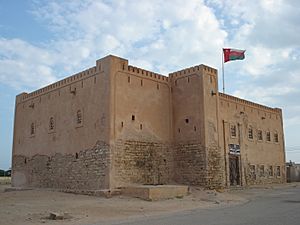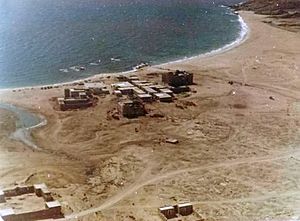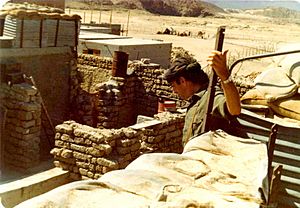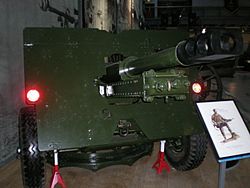Battle of Mirbat facts for kids
Quick facts for kids Battle of Mirbat |
|||||||
|---|---|---|---|---|---|---|---|
| Part of Dhofar Rebellion | |||||||
 The Wali's Fort. The Battle centred on the Dhofar Gendarmerie fort (not shown) |
|||||||
|
|||||||
| Belligerents | |||||||
|
|
|||||||
| Commanders and leaders | |||||||
| Mike Kealy | Shaheed Salim Musalim † | ||||||
| Strength | |||||||
|
10 British soldiers (9 SAS, 1 Int Corps) |
200–300 Adoo guerrillas | ||||||
| Casualties and losses | |||||||
| 2 SAS soldiers killed, 2 Gendarmes killed | 38 bodies recovered, 12 captured | ||||||
The Battle of Mirbat (19 July, 1972) was an attack by Communist guerrillas targeting an Omani government position during the Dhofar Rebellion in the town of Mirbat, Oman. During the Dhofar Rebellion, Britain assisted the Omani government, an absolute monarchy, by sending elements of its Special Air Service (SAS) both to train soldiers and fight against the Popular Front for the Liberation of the Occupied Arabian Gulf (PFLOAG) guerrillas, also known as the Adoo. The assault was defeated after the arrival of several BAC Strikemaster attack aircraft belonging to Oman, firing rockets at PFLOAG's positions which forced the guerrillas to retreat. After the battle the British and their allies recovered the corpses of the attacking guerrillas, some were put on public display as a tool of terror, to act as warnings to potential left-wing rebels who were tempted to join the rebellion against Oman's government.
Contents
Background
In 1963 a revolution began in Oman which sought to topple the government of the Sultunate of Muscat and Oman, which was backed by the United Kingdom. During the revolution, a communist guerrilla organisation was founded in 1968 called the Popular Front for the Liberation of the Occupied Arabian Gulf (PFLOAG), whom were also known as the "Adoo". The Adoo sought to establish an independent and democratic republic with a socialist economy, with equal rights for women, and a nationalised oil economy.
Battle
At 6am on 19 July 1972 the PFLOAG attacked the British Army Training Team (BATT) house based just outside the Port of Mirbat which housed nine SAS soldiers. The PFLOAG (locally known as the Adoo) attacked the SAS BATT house knowing that to be able to reach the Port of Mirbat they would first have to defeat the SAS guarding the approach to the town in Jebel Ali, a series of small desert slopes leading to the Port.
The Officer in Command, Captain Mike Kealy, observed the waves advancing on the fort, but at first did not order his men to open fire because he thought it was the "Night Picket" coming back from night shift. The Night Picket were soldiers from the Omani Army positioned on the slopes to warn the BATT house of Adoo troop movements. Realising that the Night Picket must have been killed, Kealy ordered his men to open fire. Kealy and other members of the team took up positions behind the sand-bag parapet on the roof of the BATT house, firing at the Adoo with L1A1 SLR battle rifles, with one man firing the Browning M2HB heavy machine gun, with a further two men on ground level operating and firing an infantry mortar surrounded by sand-bags. The Adoo were armed with AK-47 assault rifles, and were mortar bombing the area around the BATT house. Kealy ordered the signaller to establish communications with SAS Headquarters at Um al Quarif, to request reinforcements.
There were also a small number of Omani Intelligence Service personnel in the BATT House, a small contingent of Pakistani soldiers and a member of British Military Intelligence seconded to the OIS. They joined the team on the roof and fired on the Adoo with SLRs and other small arms. Initially some of the Pakistani soldiers were reluctant to join the defence of the fort because their roles with the BATT were largely administrative, but they obeyed orders from Mike Kealy and the British Military Intelligence Corporal.
Knowing that the SLRs would not be of full use until the Adoo were closer than the weapon's range of 800 metres, and lacking heavier firepower, Sergeant Talaiasi Labalaba made a run for the 25 Pounder Artillery Piece, which was positioned next to a smaller fort manned by nine Omani Army Special Forces soldiers, who had not played a part in the battle. The Omani policeman who was guarding the weapon had been seriously wounded. Talaiasi Labalaba managed to operate the weapon, which is a six-man job, by himself and fire a round a minute at the approaching Adoo, directing their attention away from the BATT house. Kealy received a radio message from Talaiasi reporting that a bullet had hit his face, he was badly injured, and was struggling to operate the gun on his own. At the BATT house Kealy asked for a volunteer to run to Talaiasi's aid. Trooper Sekonaia Takavesi volunteered to go.
Sekonaia Takavesi ran from the BATT house, with the remaining men providing covering fire, in an attempt to distract the Adoo. Sekonaia ran the 800 metres through heavy gunfire, and reached the gun emplacement. Sekonaia tried to give aid to his injured friend, while firing at the approaching Adoo with his personal weapon. Realising that they needed help, Sekonaia tried to raise the small number of Omani soldiers inside the smaller fort, and Walid Khamis emerged. The remaining Omani soldiers in the fort engaged the enemy with small arms fire from firing positions on the roof and through the windows of the fort. As the two men made it back to the emplacement, the Omani soldier fell wounded after being shot in the stomach with a 7.62 mm bullet. Adoo continued to advance upon both the BATT house and the artillery emplacement. At one point, the Adoo were so close that Sekonaia and Talaiasi fired the weapon at point blank range, aiming down the barrel. Talaiasi crawled across a small space to reach a 60 mm Infantry Mortar, but fell dead after being shot in the neck. Sekonaia, also shot through the shoulder and grazed by a bullet to the back of his head, continued to fire at the approaching Adoo with his personal weapon. The squad signaller sent messages through to the main Forward Operating Base, to request air support and medical evacuation for the men in the gun emplacement.
Captain Kealy and Trooper Tobin made a run to the artillery piece. Upon reaching it, they dived in to avoid increasingly intense gunfire from the Adoo. Sekonaia continued to fire on the attackers, propped up against sand bags after being shot through the stomach (the bullet narrowly missing his spine). The Adoo threw several hand grenades, but only one detonated, exploding behind the emplacement with no one injured. During the battle, Trooper Tobin attempted to reach over the body of Talaiasi. In so doing, Tobin was mortally wounded when a bullet struck his face. By this time, BAC Strikemaster light-attack jets of the Sultan of Oman's Air Force had arrived and began strafing the Adoo in the Jebel Ali. With a low cloud base making for low-altitude attack runs, only machine-guns and light rockets were used. One of the Strikemasters was sufficiently damaged by Adoo fire that it had to return to base before using up all its weapons. Reinforcements arrived from G Squadron and, defeated, the PFLOAG withdrew at about 12:30. All wounded SAS troopers were evacuated, and given medical treatment. Trooper Tobin eventually died in hospital, directly to the gunshot wound to his face.
Aftermath
25-pounder gun
The 25-pounder gun (now known as the "Mirbat gun") used by Fijian Sergeant Talaiasi Labalaba during the siege is now housed in the Firepower museum of the Royal Artillery at the former Royal Arsenal, Woolwich. Before being killed in action, Sgt Labalaba singlehandedly operated the 25-pounder gun, a weapon normally requiring four to six soldiers to operate. Labalaba's actions were a key factor in halting the Adoo's assault on the emplacement, allowing time for reinforcements to arrive. Labalaba was posthumously awarded a Mention in Dispatches for his actions during the Battle of Mirbat, though some of his comrades have since campaigned for him to be awarded the more prestigious Victoria Cross.
Public display of corpses
After the battle the Omani and British managed to recover the corpses of 38 PFLOAG (Adoo) guerrillas who had attacked Mirbat. Some of these corpses were taken to be put on public display and used as tools of terror and act as warnings to anyone who would resist the Sultan.
British medals and awards
Kealy received the Distinguished Service Order, Takavesi the Distinguished Conduct Medal, Bennett and Taylor the Military Medal. These were announced three years after the event. An Omani from the fort, Walid Khamis, was injured during the battle and received the Sultan's Gallantry Medal - Oman's highest award. The British Military Intelligence Corporal received a medal for gallantry from the Sultan (for this action and others), but was threatened with disciplinary action by the British Army for being directly involved in the action at Mirbat.
British troops present
The following SAS troopers were present at Mirbat on 19 July 1972:
- Captain Mike Kealy
- Staff Sergeant Talaiasi "Laba" Labalaba (Killed in action)
- Sergeant Bob Bennett
- Corporal Roger Cole
- Corporal Jeff Taylor
- Lance Corporal Pete Warne (Also known as Pete Wignall, Pete Winner & Soldier I, nickname Snapper)
- Trooper Sekonaia "Tak" Takavesi
- Trooper Thomas Tobin (Died of wounds)
- Trooper Austin "Fuzz" Hussey
See also
- Dhofar Rebellion
- Oman
- PFLOAG




